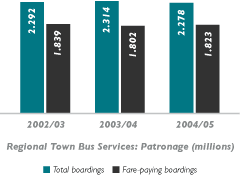Efficiency
The cost per 1000 place kilometres
(see the
Performance Indicators section of this Annual Report)
rose in 2004/05 because of a change in reporting
gross, not net, expenditure. Excluding this, the costefficiency
did not change significantly.
Passenger and occupational safety
At 30 June 2005,
passenger and occupational safety
records were maintained by individual operators. RTBS
is developing a standardised reporting format for all
regional town bus services to facilitate RTBS
maintaining such records as from 2005/06.
REVIEW OF PERFORMANCE
The Year’s Developments
The total capacity
provided on regional bus passenger
services increased by 9.1 per cent from 163.089
million passenger place kilometres in 2003/04 to
177.860 million in 2004/05. The increase mainly
resulted from:
- the full-year benefit of service enhancements
introduced in Bunbury and Busselton during the
previous year;
- the benefit of service enhancements introduced
in Port Hedland and Kalgoorlie;
- the expansion of the trial
road coach service
running from Perth to Port Hedland from one
to two return services per week in the middle
of April 2005;
- the expansion, on a trial basis, of the four-wheel
drive service providing transport between Port
Hedland, Marble Bar and Nullagine, and
Newman and Nullagine; and
- the introduction of a trial youth
bus service
between the towns of Wickham, Roebourne,
Karratha and Dampier. In June 2005, the service
was extended to Point Samson.
During the year, six country bus
operators entered into
12-year contracts with the PTA, while three metropolitan
based operators entered into contracts of
varying terms to provide services in a complementary
capacity to Transperth. In addition, a formal contract was
signed with the Shire of East Pilbara for the four-wheel
drive service operated in the Pilbara.
At year’s end,
a bus replacement program proposing
the transfer of Mercedes Benz NH low-floor buses
from the Transperth fleet to regional services in the
future was being developed.This proposal, if accepted,
will reduce the average age of the regional bus fleet to
around 12 years and provide accessible buses on
regional bus services and will be the start of RTBS
progressively complying with the Disability Standards
for Accessible Public Transport and Guidelines under
the Disability Discrimination Act, 1992. |
|
The
Transperth timetable format was adopted on bus
services in major regional towns which brought about
timetable uniformity across the State. Also, work began
on implementing a standard bus stop system in the
regional areas with orange posts designated for general
commuter stops and blue posts for school bus stops.
At 30 June
2005, the regional bus fleet totalled 134
vehicles compared with 145 in 2003/04.The decrease
primarily resulted from Transperth taking over some of
the services that were previously administered by
RTBS operators in the Perth metropolitan area.
Three late-model
low-floor wheelchair accessible
Mercedes Benz buses were transferred from
Transperth to the TransGoldfields fleet in October
2004 for use on revised services in Kalgoorlie-Boulder.
Revised town and school bus services were introduced
in Geraldton (from 15 November 2004) and Albany
(from 19 December 2004). In Geraldton, the new
services include a City Clipper route via the museum
and the HMAS Sydney Memorial.
Revised routes and improved service
levels were
introduced in Port Hedland on 4 January 2005.
Patronage
Fare-paying initial boardings on regional bus services
increased by 1.2 per cent from 1.802 million in
2003/04 to 1.823 million in 2004/05. However, total
boardings (which include free travel and transfers)
decreased by 1.5 per cent from 2.314 million in
2003/04 to 2.278 million.
As a result of the decrease in total
boardings and an
11.6 per cent increase in service kilometres, total
boardings per service kilometre fell by 11.5 per cent
from 0.96 in 2003/04 to 0.85.

|

